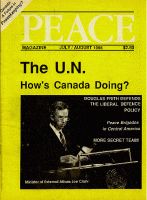
Peace Magazine Aug-Sep 1988, page 23. Some rights reserved.
Search for other articles by Eva Torok here
Sam Keen, Faces of the Enemy: Reflections of the Hostile Imagination. New York: Harper and Row 1988; 200pp
Faces of the Enemy: Reflections of the Hostile Imagination. By Sam Keen. New York: Harper & Row, 1988. 200pp. Illustrated.
Conservatives, writes Sam Keen, want to subdue the enemy by building bigger weapons while, the liberals want to make the enemy his friend by building smaller ones. Neither approach will work because each is based on the assumption that human beings are reasonable and pragmatic and should therefore be able to make peace by rational negotiation and arms control. In a book that could have been called The Killer Inside Us, Keen urges us to stop looking for an external enemy and concentrate on the one within, his premise being that in addition to being homo sapiens (rational humans), and homo faber (tool-making humans), we are also homo hostilis, enemy makers.
This book is essentially an analysis of the psychology of enmity through Jungian optics. The underlying notions are that we have a shadow, a part of us that harbors our more nefarious personality traits. But because we prefer to deny the existence of these traits, we unconsciously project them onto others and make them into scapegoats. We become obsessed with destroying the scapegoat because it is the incarnation of our evil side. This process, which also occurs between nations and peoples, has led to the creation of a "warrior psyche," of which Keen insists we must become conscious. Only by acknowledging the war between good and evil parts of the self can we begin to think about eliminating warfare in the world around us. Without this reconciliation of the self, we experience paranoia, the struggle between trust and mistrust. Likewise, nations experience consensual paranoia. Keen admits that the task of moving away from paranoia is an enormous one, given that for practical reasons it must begin on a personal level whereas, ideally, it should involve everybody. Reading this book is a good way to start because Keen's thought-provoking analysis of enmity makes an appeal to the reader as individual to search for traces of it within himself.
Political cartoons, propaganda posters and caricatures from all sides of this century's major conflicts vividly illustrate Keen's categories of enemy depiction. Included are Viet-Cong cartoons that show the United States as a paper tiger, Nazi caricatures of the Soviets as barbarians, and American World War II posters that depict the German and Japanese enemy as rapists. The judicious use of illustrations demonstrates the same metaphors occur in every nation's or people's image of the enemy: the Faceless Enemy , the enemy as Enemy of God , as Rapist, Beast, Reptile, Insect, Germ, and Death. .
Faces of the Enemy is well-written, inspiring, and versatile in its plea for us to consider another perspective in the quest for peace. Keen is as much concerned with the education of homo amicus (friendly human) as he is with the psychological analysis of homo hostilis. For a peace studies curriculum he suggests such areas of study as the history of warfare, the history of peace, paranoia and propaganda, authority and individual conscience. The accompanying study guide available with the book makes it ideal for classroom use.

Peace Magazine Aug-Sep 1988, page 23. Some rights reserved.
Search for other articles by Eva Torok here